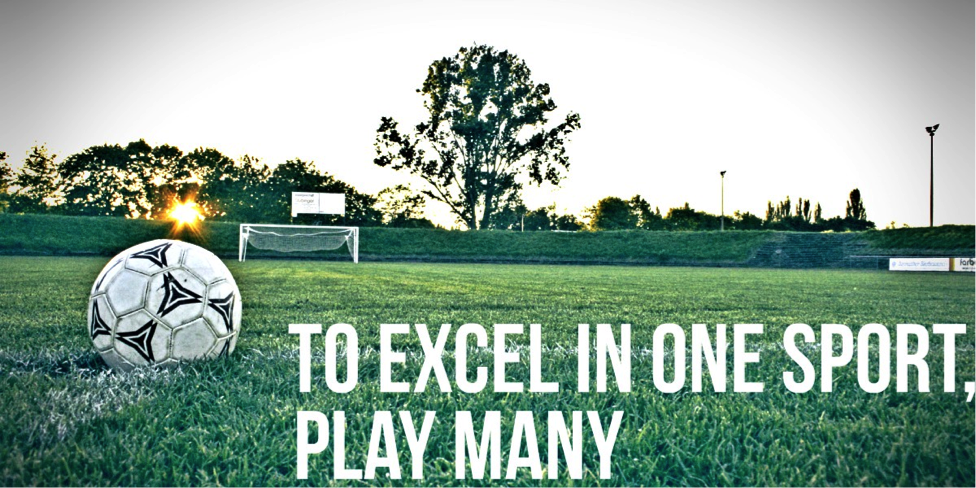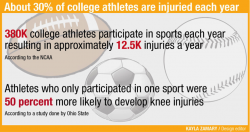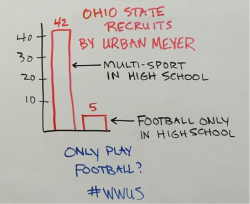How Early Specialization in Sport Can Cause Injury and Hinder Future Performance

I love youth sports. I love the passion and dedication that young athletes have for the game. I love to watch teammates bond and friendships grow, forged from countless hours of practice and competition. I love to see the timid athlete find her swagger as she scores her first goal, drains her first three, or runs her PR.
As winter melts into spring, the weather isn’t the only thing that’s changing; by now, winter sports for high school athletes have concluded. Hockey players are hanging up their skates and picking up their lacrosse sticks, or grabbing a bat to take swings in the cage. Basketball players turn to track or tennis. For some, it’s time to hit the links. They say variety is the spice of life, but for some youth players, parents, and coaches there is a common misconception that the only way to play at the next level is to specialize in one sport, and play it year-round. High school hockey in the winter, club team in the spring and/or fall, and multiple summer camps.
Researchers from the University of Wisconsin refute that notion with a new study published in the journal Sports Health. They determined that of the 343 Division I athletes studied (228 male, 115 female) from 9 different sports, the majority were not highly specialized in high school. And while most athletes will eventually specialize in one sport, it is by no means a requirement to become a Division I athlete.
So, sport specialization may not be a requirement to play in college, but are there any downsides to playing a sport year-round? Actually, yes. Major ones. The authors of the study cite “multiple adverse outcomes such as psychological burnout, altered movement patterns and injury.” Psychological burnout is when athletes no longer find joy in the sport they once loved, and often quit as a result of the increased stress or pressure to compete in one sport. Symptoms, which should not be minimized, include poor performance in school and sport, joint pain, and fatigue. Mental health issues stemming from sports burnout can be wide-ranging, affecting performance across the board, and can be addressed by professionals such as sports psychologists or social workers.
As a physical therapist (and what should also be a red flag to you as a parent, coach, or athlete) the idea of altered movement patterns and their contribution to injury is a serious concern. In Pediatrics, the official journal of the Academy of Pediatrics, a 2007 study2 notes that about HALF of all pediatric sports injuries are related to overuse. This includes shoulder, hip, and knee injuries. In 2013, Dr. Timothy Hewett from Ohio State University found in one long-term study3 of 500+ females that those who only played one sport had a 50% increased risk of knee injury.

When repetitive motions create altered movement patterns, injuries are imminent. Due to the demands of the sport, rotator cuff tears and shoulder impingement are common in swimmers, tennis or volleyball players; ACL injuries and ankle sprains are frequent in soccer players; and groin or hip injuries (including labral tears) are typical among hockey players.
Want a specific example? When a baseball pitcher goes through his throwing motion, the elbow is stressed, especially the ulnar collateral ligament (UCL) that attaches the humerus (upper arm) to the ulna (forearm). With overuse, including increased velocity, pitch count, fatigue, and implementation of breaking pitches, the UCL is subject to tearing. Tommy John surgery is a procedure to repair that ligament so the player can return to sport. In the MLB today, 1 in 4 pitchers has had this procedure, with a typical recovery time of 12 months. A study co-authored by Dr. Anthony Romeo, our local Chicago orthopedic surgeon and team physician for the White Sox and Bulls, found that while Tommy John surgery was previously reserved for MLB players, today youth pitchers ages 15-19 make up over 60% of these procedures, with that number rising 9% annually4. Recovery is not guaranteed and before you ask, there is no evidence to suggest that velocity increases following the procedure and no, you should not have this procedure done prophylactically.
Still not convinced? As a former youth hockey coach, I can unequivocally say that the best (most talented) hockey players I coached played multiple sports: football, soccer, lacrosse, or track. When evaluating kids, I didn’t want hockey players, I wanted athletes. How about more accomplished coaches? In 2014, of the 72 players recruited to play college football at Alabama, Ohio State, and Notre Dame, 61 (85%) were multi-sport athletes. By 2015, Urban Meyer (who by the way has won three college football national championships) had recruited 47 high school football players to play for the Buckeyes; 42 were multi-sport athletes. Does this trend translate to the pros? Do you really need to ask? In the 2016 NFL Draft, 28 of the 31 first round picks played multiple sports in high school. That’s 90%!
Some of your favorite athletes played multiple sports:
Wayne Gretzky (hockey) played lacrosse, baseball, soccer and track growing up
Tom Brady (football) was drafted to play baseball, before he (arguably) became the GOAT
Jim Brown (football) is in the Lacrosse Hall of Fame
Abby Wombach (soccer) attributes much of her success with heading the ball (before she retired, she was the best in the world) to learning how to rebound a basketball
Jackie Robinson lettered in 4 sports at UCLA: baseball, football, basketball and track, before breaking the MLB color barrier.
Babe Didrickson, Bo Jackson, John Elway, Dave Winfield, Jim Thorpe, Dion Sanders… the list goes on and on.
Playing multiple sports in high school is a great way to improve strength, agility, proprioception, and flexibility, while reducing your risk for overuse injury and burnout. It could even be a springboard to playing at the collegiate level and beyond. Make more friends, play in different environments, and have more fun. Challenge yourself. It’s what youth sports are all about.
PS: below are some guidelines from the American Academy of Pediatrics regarding sport and how to avoid overuse injuries and psychological burnout:
- Encourage athletes to strive to have at least 1 to 2 days off per week from competitive athletics, sport-specific training, and competitive practice (scrimmage) to allow them to recover both physically and psychologically.
- Advise athletes that the weekly training time, number of repetitions, or total distance should not increase by more than 10% each week (eg, increase total running mileage by 2 miles if currently running a total of 20 miles per week).
- Encourage the athlete to take at least 2 to 3 months away from a specific sport during the year.
- Emphasize that the focus of sports participation should be on fun, skill acquisition, safety, and sportsmanship.
- Encourage the athlete to participate on only 1 team during a season. If the athlete is also a member of a traveling or select team, then that participation time should be incorporated into the aforementioned guidelines.
- If the athlete complains of nonspecific muscle or joint problems, fatigue, or poor academic performance, be alert for possible burnout. Questions pertaining to sport motivation may be appropriate.
- Advocate for the development of a medical advisory board for weekend athletic tournaments to educate athletes about heat or cold illness, over participation, associated overuse injuries, and/or burnout.
- Encourage the development of educational opportunities for athletes, parents, and coaches to provide information about appropriate nutrition and fluids, sport safety, and the avoidance of overtraining to achieve optimal performance and good health.
- Convey a special caution to parents with younger athletes who participate in multigame tournaments in short periods of time.
RESOURCES
1. https://www.ncbi.nlm.nih.gov/pubmed?term=%22Sports+health%22[Jour]+AND+Post[author]&cmd=detailssearch
2. http://nyshsi.org/wp-content/uploads/2012/08/AAP-Clincal-report-on-overuse-injuries-2007.pdf
3. https://www.ncbi.nlm.nih.gov/pmc/articles/PMC4247342/
4. https://www.researchgate.net/profile/Benedict_Nwachukwu/publication/
